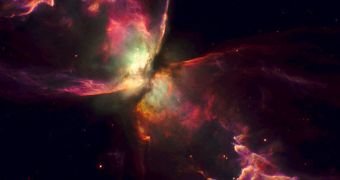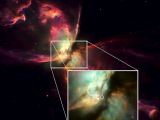The Bug Nebula is one of our galaxy's space structures that has been observed by scientists on several separate occasions, with the express purpose of imaging the star at its core. In spite of their best efforts, the research groups failed to do so until just recently. Using an advanced observatory, experts at the University of Manchester Jodrell Bank Center for Astrophysics recently managed to peer inside the nebula, and capture a unique look at the giant star inside. They found that the dying celestial body is one of the hottest stars inside the Milky Way, Space Fellowship reports.
“This star was so hard to find because it is hidden behind a cloud of dust and ice in the middle of the nebula. Planetary nebulae like the Bug form when a dying star ejects much of its gas back into space and are among the most beautiful objects in the night sky. Our own Sun will do this in about 5 billion years' time. The Bug nebula, which is about 3,500 light years away in the constellation Scorpius, is one of the most spectacular of all planetary nebulae,” UM Professor Albert Zijlstra says. According to the team's observations, the star in the Bug Nebula is heated to more than 200,000 degrees, which is roughly more than 35 times our Sun's “measly” 5,780 °Kelvin (5,510 °Celsius).
In a paper to be published in next week's issue of the respected Astrophysical Journal, the team describes how it used the newly refurbished Hubble Space Telescope, which resumed its mission to scout the Universe this September, to peer at the heart of the planetary nebula. While browsing through the set of spectacular images that the venerable observatory sent back, the experts were surprised to discover an image of the actual central star, something they refrained from hoping to find.
“We are extremely lucky that we had the opportunity to catch this star near its hottest point, from now on it will gradually cool as it dies. This is truly an exceptional object,” European Southern Observatory (ESO) expert Cezary Szyszka says. The scientist is a UM research student, and also the lead author of the upcoming paper. “It’s extremely important to understand planetary nebulae such as the Bug Nebula, as they are crucial to understanding our own existence on Earth,” Professor Zijlstra explains. One of the main reasons for this is the fact that carbon, the chemical element on which life forms such as ourselves are based, is ejected from planetary nebulae such as the Bug.
“How a star ejects a nebula like this is still a mystery. It seems most stars, including the Sun, will eject as much as 80 per cent of their mass when they finally run out of nuclear fuel at the end of their lives. Material that then goes on to help form the next generation of stars and planets,” UM researcher Dr. Tim O’Brien adds.
“These observations have shown that the star at the heart of the Bug Nebula is only about 2/3 as heavy as the Sun, but was several times heavier before it threw off its outer layers to form the nebula which had previously hidden it from our view. Images like these are remarkable not only for their beauty but also for what they tell us about our own origins,” he concludes.

 14 DAY TRIAL //
14 DAY TRIAL // 
